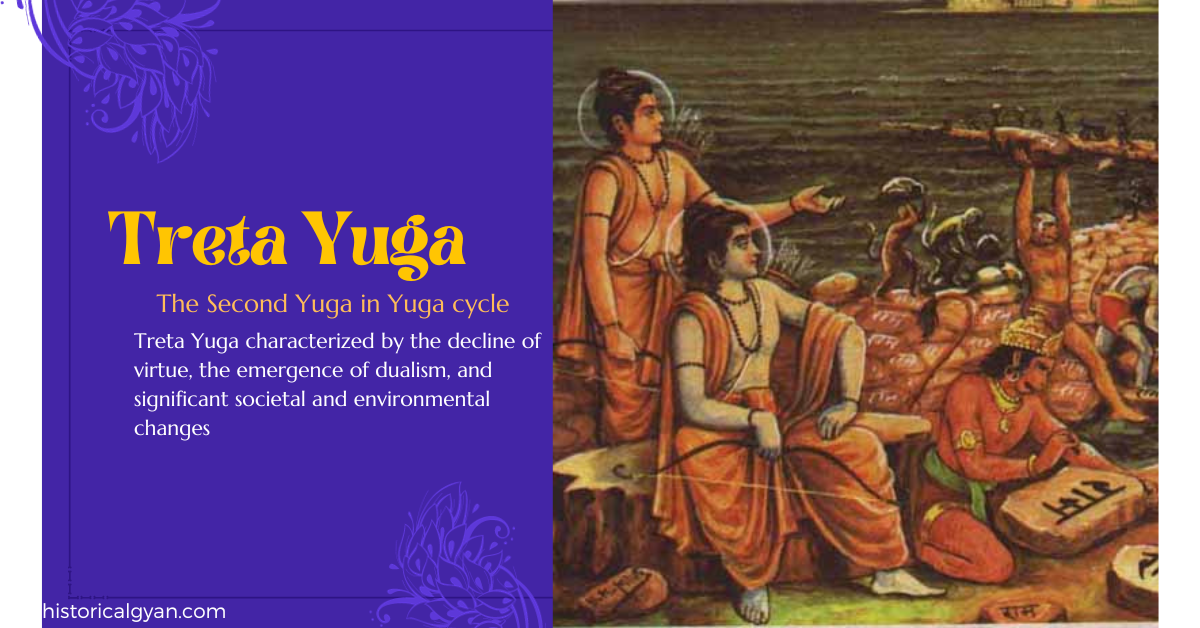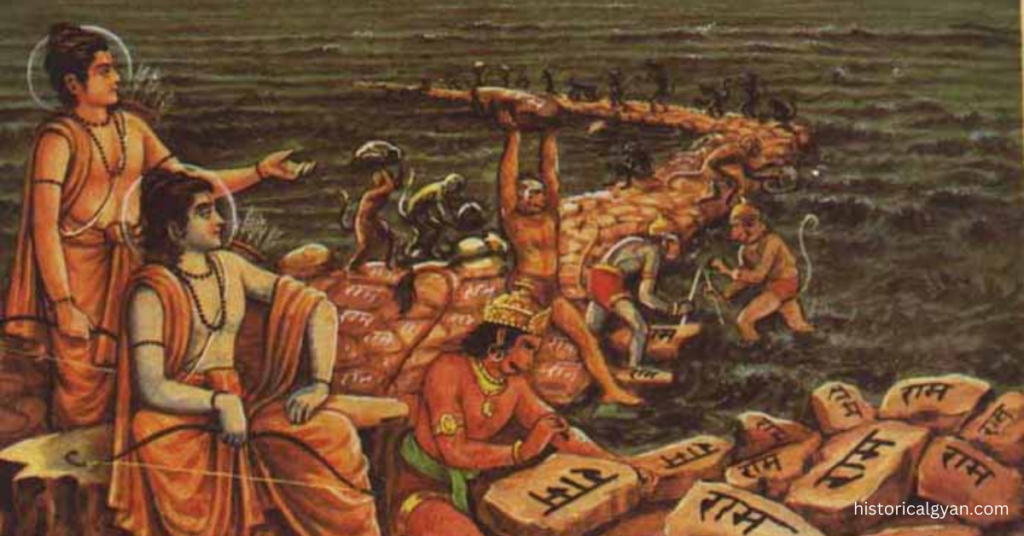
Origins of Treta Yuga
Treta Yuga, also spelled in Devnagri “(त्रेता युग),” is the second of the four ages, or epochs, in Hinduism’s cosmic time cycle. The term “Treta” originates from the Sanskrit language, signifying ‘a collection of three things.’ This nomenclature finds its relevance in the Treta Yuga due to the manifestation of three significant Avatars of Lord Vishnu during this era. These Avatars correspond to the fifth, sixth, and seventh incarnations of Vishnu, taking the forms of Vamana, Parashurama, and Rama, respectively. Whereas Treta Yuga saw a slight decline in the overall quality of life. religion the bull stood on three legs.
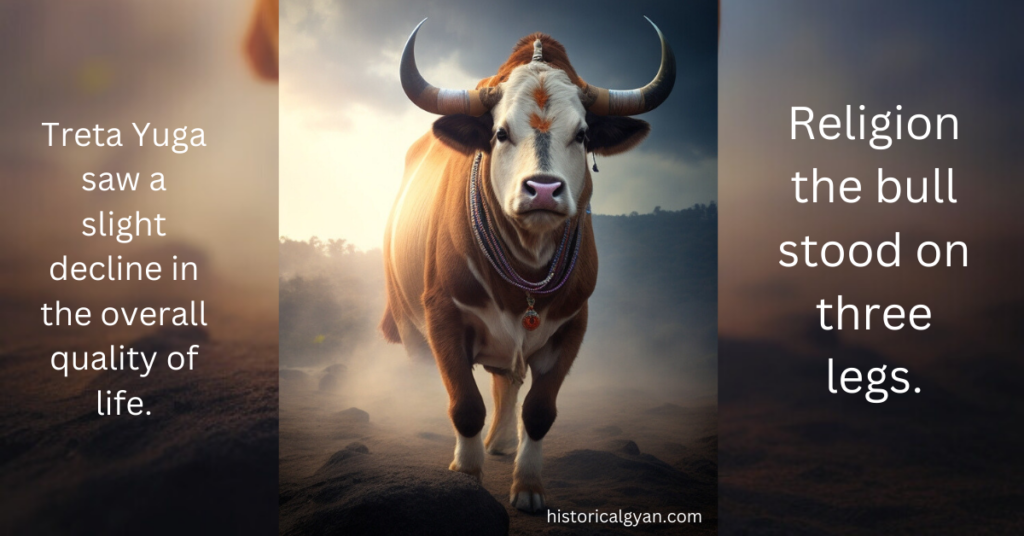
Treta yuga time period
The name “Treta Yuga” could also be associated with the fact that this age extends for a duration of 3,000 divine years.
Treta-yuga = 3000 divine years,
Sandhya = 300 divine years,
Sandhyansa = 300 divine years.
Total = 3600 divine years x 360 days =
1,296,000 human years.
The Diminishing Virtue of Treta Yuga
As Treta Yuga unfolds, a perceptible decline in virtue becomes apparent. This decline marks a stark contrast to the pristine virtue of Satya Yuga, as the essence of truth and righteousness gradually wanes. The goodness that endures in the hearts of humans is now entwined with the ever-increasing influence of Tamas and Rajas.
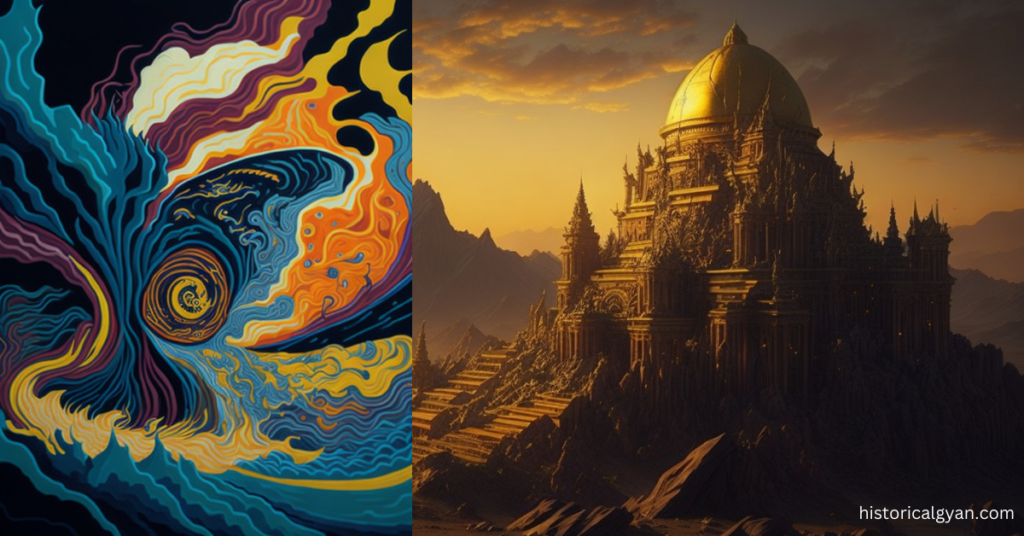
Tamas and Rajas in Treta Yuga
Tamas represents the shadowy aspects of human nature, while Rajas embodies the fervent passions that stir within us. In the realm of consciousness, Treta Yuga introduces a subtle dualism that holds profound implications for the subsequent Yugas. Inhabitants of this age find themselves gradually succumbing to materialism, drifting away from spiritual pursuits. However, it’s crucial to acknowledge that this transformation is a gradual process.
The Transformations of Treta Yuga
- The Emergence of Wars and Environmental Shifts: Treta Yuga witnesses the emergence of wars as a manifestation of the deepening dualistic consciousness. Conflict, both internal and external, becomes an integral part of the human experience. Simultaneously, the natural world undergoes dramatic changes, leading to the formation of vast oceans and deserts. It is during this age that agriculture and mining come into existence, accompanied by the establishment of rules and regulations to maintain societal order.
- The Revelation of Universal Magnetism: Despite the seemingly adverse effects of growing dualism, Treta Yuga unveils the profound knowledge of universal magnetism. This knowledge empowers humans to comprehend the intricate forces of nature and the universe through a logical lens. While the overall quality of life experiences a subtle decline, Treta Yuga remains a glorious epoch, symbolized by the Dharma Bull standing resolutely on three legs.
- The Birth of Agriculture and Mining: Despite the seemingly negative effects of dualism, Treta Yuga brings forth profound advancements. Agriculture and mining come into existence during this age, ushering in a new era of sustenance and resource utilization. Rules and regulations are established to maintain order in society, reflecting humanity’s need for structure amidst growing complexities.
The Dominance of Mental Powers
Treta Yuga predominantly represents the age of the mind, characterized by the harnessing of psychic abilities. These extraordinary powers lead to numerous inventions, particularly aimed at unraveling the illusion of time itself. Religion continues to thrive during this period, with the highest virtue being Yajna or sacrifice. Significant social and planetary shifts unfold during Treta Yuga. The people cultivate a heightened level of intellect, albeit at the cost of some control over their physical bodies. The stature of humans diminishes compared to the lofty heights of Satya Yuga, yet exceptional individuals rise, boasting godly strength and divine wisdom.
The Divine Avatars of Lord Vishnu in Treta Yuga
Treta Yuga is also the time when the first human avatars of Vishnu make their appearances. Three notable incarnations take place:
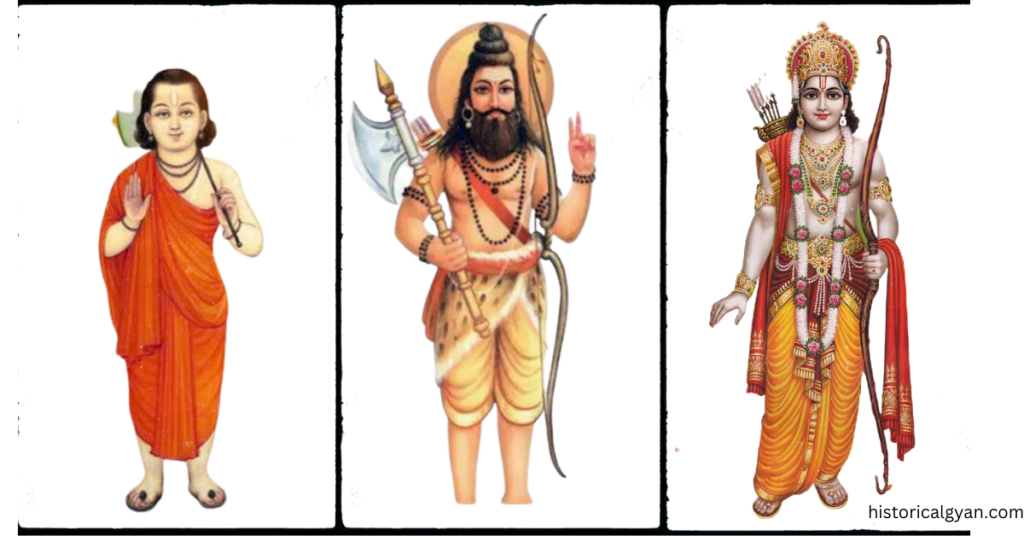
Vaman Avatar
In the Vaman Avatar, Vishnu takes on the form of a brahmana dwarf named Vamana. His purpose is to save the Devas and prevent the Asura King Bali from conquering all three worlds. This avatar showcases Vishnu’s selflessness and commitment to maintaining cosmic order.
Vamanadeva, also known as the Dwarf Incarnation, is the fifth among the Dashavatar, a divine series of incarnations. He made His appearance during the Treta Yuga with the purpose of reclaiming the celestial realm from the dominion of King Bali and his malevolent forces. Additionally, Vamanadeva played a pivotal role in rescuing Lord Shiva from the clutches of the wicked Vrikasura.
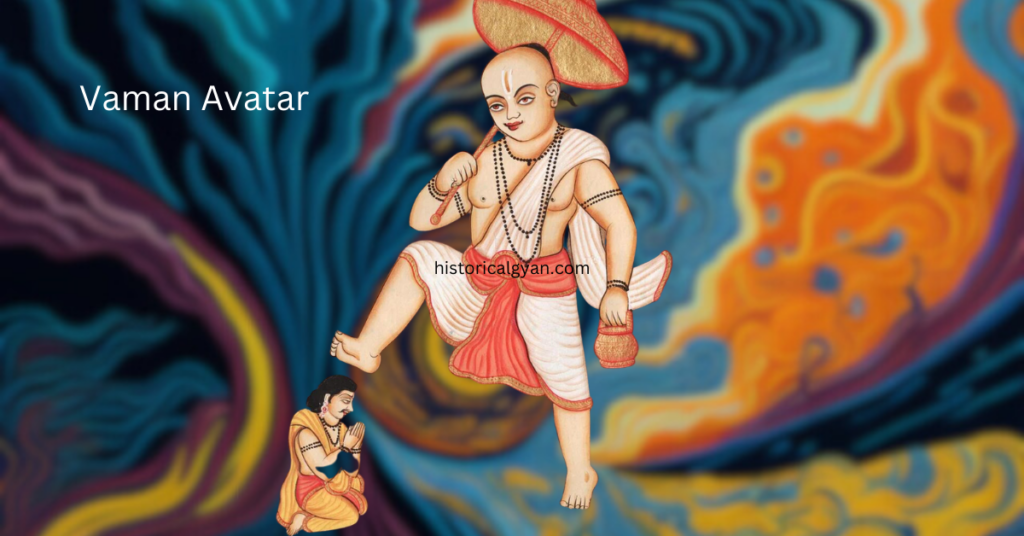
King Bali, the illustrious grandson of Prahlada, had conducted numerous Vedic sacrifices to amass great power. Upon the successful completion of these rituals, Bali led his formidable army in a conquest to seize Indra’s heavenly kingdom, Svarga. Bestowed with blessings from Vedic priests, Bali had become nearly invincible. In the face of this impending danger, Indra, along with his wife and associates, was forced to abandon his celestial realm. The plight deeply distressed Indra’s mother, Aditi, who longed for Vishnu to intervene, defeat Bali, and restore her son to the throne of heaven.
Aditi approached her husband, Kasyapa, seeking his blessings to bear an exceptionally powerful son, desiring none other than the Supreme Being, Vishnu Himself, to be born as her child. In due time, Vishnu manifested as the Dwarf Incarnation, Lord Vamana, from Aditi’s womb. Vamana assumed His eternal form and proceeded to the sacred sacrificial arena in Svarga.
There, He encountered King Bali, who warmly received Him and offered to grant Him a boon. With a smile, Vamana made a seemingly modest request, asking for only three paces of land. Bali readily agreed to this humble plea. To the astonishment of all, Vamana swiftly transformed into a colossal form, encompassing the entire universe with just two strides. With His third step, Vamanadeva graciously placed His foot upon Bali’s head.
In this act, Vishnu, in His Vamana form, triumphed and reinstated the heavenly realm of Svargaloka to the demigods, thus fulfilling the fervent prayers of Aditi and ending the rule of the demon king Bali.
Parasuram Avatar
Born to the pious sage Jamadagni and Renuka, Vishnu incarnates himself as a brahmana priest in the Parasuram Avatar. This unique incarnation is immortal and is counted among the seven Chiranjeevis (immortals). Parasuram chooses the path of a warrior to combat the abuse of power by the Kshatriyas who misuse their authority.
Parashurama, one of the most formidable avatars, emerges as a warrior with a relentless mission to vanquish twenty-one successive generations of ruthless, power-hungry kings. His formidable reputation is rooted in a dramatic episode from His youth.
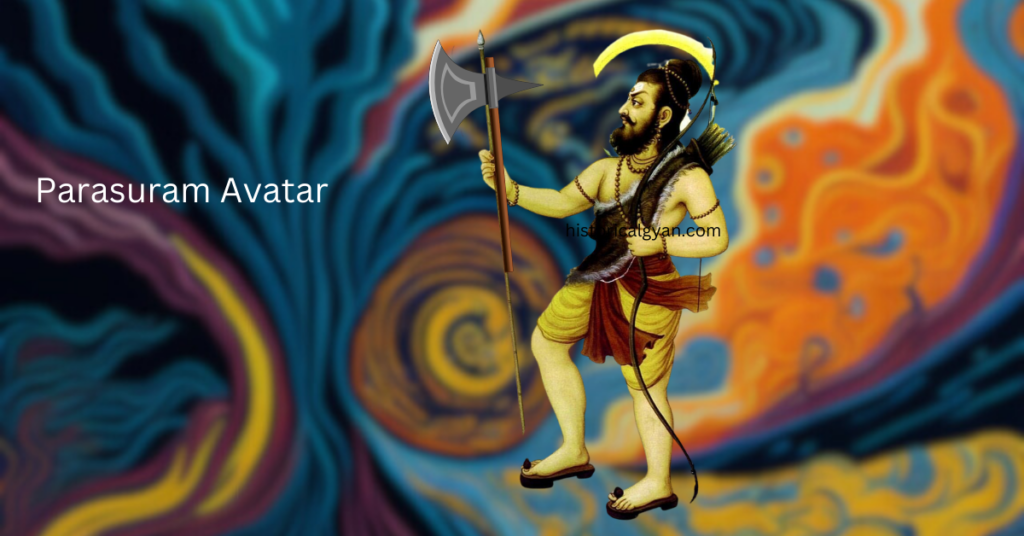
As a young boy, Parashurama’s father, Jamadagni, grew greatly distressed by the actions of his wife and other children. In an astonishing request, he implored Parashurama to eliminate them. Parashurama, aware of his father’s mystic powers, cultivated through years of rigorous austerity and meditation, contemplated the situation.
He reasoned that if he didn’t carry out the deed, his father would do so himself. He believed that by obeying his father’s wishes and performing this difficult task, he could earn his father’s blessings. With those blessings, he intended to beseech his father to revive his mother and siblings.
As fate would have it, Parashurama did carry out this heart-wrenching act, and in turn, Jamadagni bestowed upon him a benediction. Parashurama then utilized this divine favor to beseech his father to resurrect his family members. Remarkably, Jamadagni fulfilled this request, bringing Parashurama’s family back to life.
Parashurama’s renown extends beyond this poignant tale, as He is also celebrated for accomplishing the seemingly impossible feat of defeating the invincible warrior, King Kartaviryarjuna.
Rama Avatar
The seventh incarnation of Lord Vishnu takes the form of Rama, a noble prince. Rama’s mission is to save the land from evil forces and establish dharma (righteousness) by vanquishing the demon king Ravan in a monumental war. Although warfare is not a defining characteristic of Treta Yuga, it is during this time that the legendary battle recounted in the Ramayana takes place.
One of the most renowned among the ten primary incarnations, or Dashavatar, Lord Rama manifests as the Supreme Being taking on a human form. He is born as the son of King Dasaratha and Queen Kaushalya, and His divine purpose is to vanquish the malevolent demon king, Ravana.
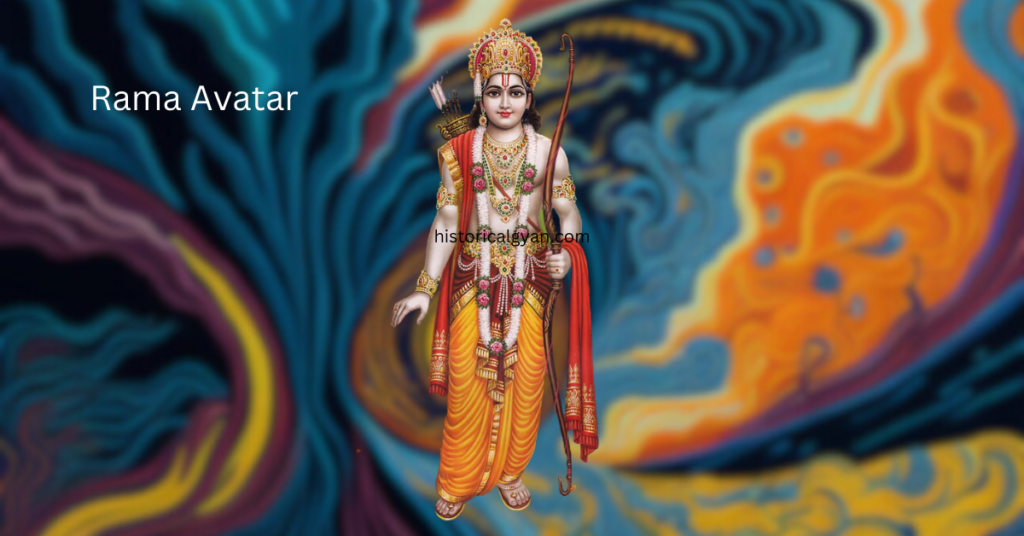
In His youth, Rama receives an invitation from the venerable sage Visvamitra to aid in the elimination of numerous rakshasas, or flesh-eating demons. Accompanied by His devoted brother, Lakshman, Rama embarks on this mission under Visvamitra’s guidance. During this sojourn, Rama acquires the knowledge of invoking various mystic weapons and mantras.
Rama’s remarkable journey takes a dramatic turn when He competes for the hand of Princess Sita. The competition centers around breaking a colossal bow that once belonged to Lord Shiva. Rama successfully accomplishes this Herculean task, winning Sita’s heart.
However, destiny takes a challenging twist as a conspiracy unfolds, resulting in Rama’s banishment from His father’s palace, condemning Him to fourteen years of exile. Despite His reluctance, Rama allows both Sita and Lakshman to accompany Him, and they embark on a journey far from the comforts of the kingdom, embracing a life of seclusion in the wilderness.
Tragedy strikes when Sita is abducted by the cunning Ravana, plunging Rama into a relentless quest to locate her and secure her rescue. Overcoming numerous trials and tribulations, Rama eventually discovers Ravana’s kingdom, Lanka, and engages in a fateful battle with the demon king. In a climactic showdown, Rama vanquishes Ravana and reunites with His beloved Sita, marking the triumphant conclusion of this epic saga.
In conclusion,
Treta Yuga represents a pivotal phase in Hindu cosmology, characterized by the decline of virtue, the emergence of dualism, and significant societal and environmental changes. Despite the challenges, it remains a glorious era marked by the harnessing of psychic powers, the flourishing of religion, and the advent of notable divine incarnations. Understanding Treta Yuga provides us with valuable insights into the cyclical nature of human existence and the eternal quest for righteousness.
Frequently Asked Questions (FAQs):
1. What is Treta Yuga, and how does it fit into the cosmic cycle?
Treta Yuga is the second yuga of the four Yugas or Maha yuga in Hindu cosmology. It is characterized by a decline in virtue compared to Satya Yuga and marked by increasing dualism in human consciousness.
2. Why does Treta Yuga precede Dwapar Yuga, despite the numerical order?
The order of Yugas is not strictly numerical but represents a decline in human virtue and consciousness. Treta Yuga’s placement before Dwapar Yuga is based on the spiritual and moral aspects of the ages, not their numeric sequence.
3. What characterizes the virtue of Treta Yuga compared to Satya Yuga?
In Treta Yuga, virtue declines from the pristine levels of Satya Yuga. While some goodness remains, it is accompanied by the increasing influence of Tamas (darkness) and Rajas (passion) in human nature.
4. How do Tamas and Rajas influence human nature during Treta Yuga?
Tamas represents the shadowy aspects of human nature, while Rajas embodies fervent passions. In Treta Yuga, these dualistic influences lead to a gradual shift towards materialism and a reduced inclination towards spirituality.
5. Can you explain the concept of dualism introduced in Treta Yuga’s consciousness?
Dualism in Treta Yuga refers to the coexistence of both virtuous and darker tendencies within human nature. This dualistic nature has significant implications for human behavior and choices during this age.
6. What significant events and changes occur in Treta Yuga, particularly in terms of warfare and the environment?
Treta Yuga witnesses the emergence of wars as a manifestation of growing dualism. Additionally, the natural world undergoes substantial transformations, resulting in the creation of vast oceans and deserts. Agriculture, mining, and societal regulations also come into existence.
7. How does the knowledge of universal magnetism shape Treta Yuga’s understanding of the forces of nature and the universe?
Despite the challenges posed by growing dualism, Treta Yuga brings forth profound knowledge of universal magnetism. This knowledge enables humans to comprehend the intricate forces governing nature and the universe from a logical perspective.
8. What role does mental prowess play in Treta Yuga, and what are its consequences?
Treta Yuga is marked as the age of intellect, where psychic powers are harnessed. This intellectual advancement leads to various inventions, including those aimed at manipulating time. However, this mental ascendancy comes at the cost of some control over the physical body.
9. Who are the notable divine avatars of Lord Vishnu in Treta Yuga, and what are their missions?
In Treta Yuga, both the incarnations of Lord Vishnu were Parashuram and Ram. Parashurama’s mission is to combat human abuse of power, while Rama’s objective is to restore peace and righteousness by triumphing over good over evil.
